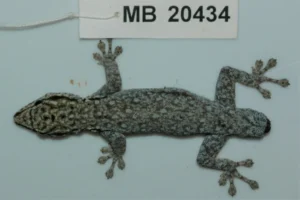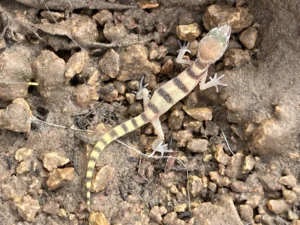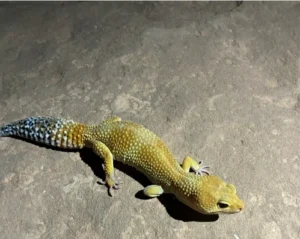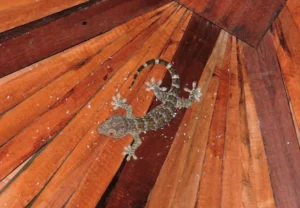If you’ve ever watched a lizard dart across a garden wall or scurry through the grass, you might have noticed something wild. One moment it has a long tail trailing behind it, and the next, poof, the tail is gone.
The lizard keeps running like nothing happened, but the detached tail keeps twitching on its own. It’s shocking, and you might wonder: why exactly do lizards drop their tails, and how does it all work?
Most lizards drop their tails to escape predators. The detached tail keeps predators distracted while the lizard makes its getaway. This defense move, called autotomy, gives lizards a real chance to survive life-or-death encounters. Some species can grow their tails back later, though the new tail often looks different and costs energy to replace.
That said, not all lizards can drop their tails ,and the way they use this trick depends on the species. Small lizards like anoles and skinks use it often, while bigger lizards like iguanas rarely do.
Basically, tail-dropping is a balance between escaping danger and managing the energy cost of losing and regrowing a tail.
How a Wiggling Tail Confuses Predators
When a lizard drops its tail, it’s not just leaving a piece of itself behind. The tail keeps flipping and wriggling, sometimes for several minutes.
That movement grabs a predator’s attention and gives the lizard time to escape.

Imagine a green anole sunning itself on a tree branch. A bird swoops down to snatch it. In a split second, the anole drops its tail.
The bird grabs the wiggling tail and thinks it caught the prey, while the lizard vanishes into the leaves. That tail just bought the lizard its life.
Even snakes and mammals can be tricked this way. The tail works like a decoy, giving the lizard just enough time to find cover.
Predators usually stop chasing once they’ve got the moving tail in their grasp.
Which Lizards Can Really Drop Their Tails, and Which Can’t?
Not all lizards have this dramatic escape trick. Many small, nimble species like anoles, skinks, and geckos can drop their tails almost at will.
Larger species, like iguanas or monitors, rarely do because the energy cost is high, and losing such a big tail leaves them vulnerable in other ways.
Here’s a quick look at which lizards can drop their tails and which generally cannot:
| Lizard Species | Can They Drop Their Tail? | Tail Regrowth Time | Notes |
|---|---|---|---|
| Green Anole | Yes | 4–6 weeks | Drops tails frequently; low energy cost, common escape tactic |
| Brown Anole | Yes | 4–6 weeks | Small garden lizard; tail wiggling distracts predators |
| Leopard Gecko | Yes | 8–12 weeks | Tail stores fat; drops mostly as last-resort defense |
| Blue-Tongued Skink | Yes | 3–5 months | Thick tail with fat storage; regrowth takes months |
| Crested Gecko | Yes | Partial / rarely full | Common pet; can drop tail once, regrowth usually not full |
| Bearded Dragon | No | N/A | Large-bodied; tail-dropping rare due to high energy and balance cost |
| Iguana | No | N/A | Large tail; dropping is uncommon, risky energy cost |
| Monitor Lizard | No | N/A | Very large; rarely uses autotomy |
| Five-Lined Skink | Yes | 6–8 weeks | Juveniles drop tails more than adults; common in North America |
| Common Wall Lizard | Yes | 4–6 weeks | Tail detachment distracts predators; regrows quickly |
| Mediterranean House Gecko | Yes | 6–8 weeks | Small gecko; tail drops easily under threat |
| Tokay Gecko | Yes | 8–10 weeks | Larger gecko; tail regrowth slower than smaller species |
| Sand Lizard | Yes | 5–7 weeks | Tail-dropping common in open habitats; helps evade birds |
| Green Basilisk | No | N/A | Large, fast; rarely uses tail-dropping |
| Frilled Lizard | No | N/A | Uses frill display rather than tail autotomy |
| Glass Lizard (legless) | Yes | 8–12 weeks | Autotomy helps escape predators even without limbs |
| Jackson’s Chameleon | No | N/A | Tail important for balance; rarely drops it |
| Madagascar Day Gecko | Yes | 6–8 weeks | Small, arboreal; tail used for balance and defense |
| Tokay Gecko | Yes | 8–10 weeks | Vibrant gecko; tail regrowth slower, shape may differ |
| Western Fence Lizard | Yes | 5–6 weeks | Common US species; drops tail to escape snakes |
Even among lizards that can drop tails, the process is different. Many have special weak spots in their tail bones (called fracture planes) that let the tail detach easily.
Others tear through soft tissue. Either way, it’s a survival move honed over millions of years.
For example, leopard geckos can drop their tails if threatened, but the tail is thick and stores fat. Losing it costs energy, so they usually only drop it as a last resort.
Green anoles, on the other hand, drop their tails frequently without major energy cost, making it a more common escape tactic.
How Lizards Regrow Their Tails, and What Changes
Lizards that drop tails can often regrow them, though the new tail isn’t an exact copy. Regrowth takes weeks to months depending on species.

A small anole may regrow a tail in 4–6 weeks, while a blue-tongued skink could take 3–5 months.
The new tail usually looks different in shape, color, and texture. Bones are replaced by cartilage, making it less flexible. It’s often shorter or more stubby than the original.
This regrowth costs energy the lizard would otherwise use for foraging, mating, or avoiding predators.
Some lizards, like geckos, also lose fat stores when they drop their tails, which can temporarily affect their health. Tail-dropping is a trade-off: escape now, pay later.
Why Losing a Tail Can Be Risky for Lizards
Dropping a tail can save a lizard’s life, but it’s not without consequences. Losing a tail reduces balance and agility, which can make climbing or escaping predators harder.
For species that store fat in their tails, losing it can temporarily reduce energy reserves.

For example, blue-tongued skinks rely heavily on their tail for fat storage. Losing it means they need to eat more to regain energy, and they may be more vulnerable until the tail grows back.
Detached tails can also attract other predators. While the tail wiggles to distract, the lizard still needs cover quickly.
If it doesn’t, it could be caught despite the distraction.
When Do Lizards Decide to Drop Their Tails?
Lizards don’t drop tails randomly. It’s usually a last-resort decision, triggered only when they feel directly threatened.
Stress, surprise attacks, or rough handling can all trigger autotomy.
For example, a curious child picking up a small anole may trigger a tail drop, even though the lizard is otherwise fine.
Lizards detect stress through nerve endings in their tails, and a chemical signal separates the tail at the fracture plane.
Some species can control whether they drop their tails. Anoles may freeze first to see if the threat passes before sacrificing their tail. It’s a very sensitive survival decision.
How Different Species Use Tail-Dropping in Unique Ways
Different lizards have adapted tail-dropping for their environments. Arboreal lizards like geckos often drop tails to escape predators in trees, where falling can be dangerous.
Ground-dwelling lizards, like skinks, might use tails as decoys on open soil.

Some species also use tails for communication or mating displays. Losing a tail can reduce their ability to attract mates until it regrows.
Male anoles, for example, may use tail wagging to signal rivals. Losing the tail temporarily removes that signaling ability.
What Happens to the Tail After It Detaches?
Once a tail is dropped, it keeps wriggling for a few minutes thanks to remaining nerve activity. This confuses predators. Eventually, the tail stops moving and becomes part of the environment.
Some predators may eat it, but most focus on the moving part and give up.
In some habitats, detached tails even decompose and add nutrients to the soil, though that’s obviously not the lizard’s intent!
How Losing a Tail Changes a Lizard’s Daily Life
A lizard without a tail needs to adjust its behavior. Balance can be affected, making climbing, running, or jumping harder. Some lizards hide more until the tail grows back.

Energy management is another concern. Without fat in the tail, lizards need to eat more. Some reduce activity to save energy, which can affect feeding or mating.
For species like skinks that rely on tails for fat, losing it can be a short-term challenge, but most small lizards adapt quickly.
Can Pets or Humans Cause Lizards to Drop Their Tails?
Yes. Rough handling by humans or pets can make a lizard drop its tail. A dog pawing at a small gecko, or a child picking up an anole too quickly, can trigger autotomy.
It’s not a sign of illness, it’s purely a defense response.
If you have pet lizards, handle them gently and only when necessary. Too much handling can stress them and cause unnecessary tail dropping.
Even careful handling carries some risk if the lizard is already stressed.
Why Tail-Dropping Is One of Nature’s Smartest Survival Tricks
Tail-dropping may seem extreme, but it’s one of nature’s cleverest survival moves. It lets lizards escape predators, survive in dangerous environments, and buy time for regrowth.
While there are risks, the benefits often outweigh the downsides.
It’s a perfect example of evolution at work; trading a part of the body to save the whole. Without it, many small lizards wouldn’t survive long in predator-rich areas.
Conclusion
Lizards drop their tails to survive, using autotomy as a clever distraction for predators. Losing a tail comes with risks (like reduced balance, lost fat stores, and temporary energy shortages) but it often saves their lives.
Different species use this trick in unique ways, and some can regrow tails over time.
Next time you see a lizard dash away with no tail, remember: that wriggling stump isn’t just odd, it’s nature’s way of keeping that lizard alive.
Tail-dropping may seem extreme, but it’s an interesting survival trick that shows just how adaptable and resilient these little reptiles really are.
Hi, my name is Ezra Mushala, i have been interested animals all my life. I am the main author and editor here at snakeinformer.com.

